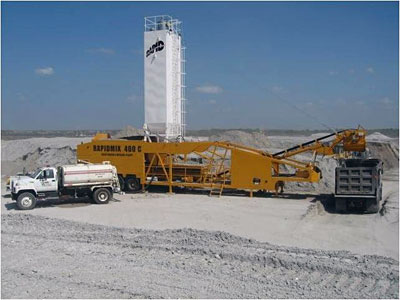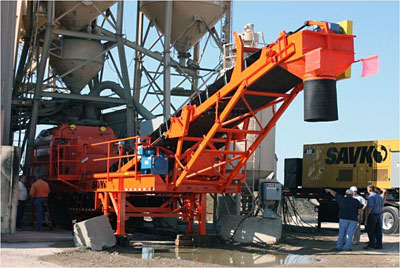Production
Roller Compacted Concrete can be produced in any type of equipment that will provide uniform mixing of the cement, aggregates, admixtures, and water. The size and nature of the project should be considered when choosing a mixing plant. Types of Roller Compacted Concrete mixing equipment include the following:
-
Continuous Flow Mixers
-
Tilt-Drum Mixers
-
Transit Mixers
-
Twin-Shaft Mixer Insert
Continuous Flow Mixers
 Continuous Flow mixers include pugmills and horizontal shaft mixing plants. With a continuous flow plant, the materials are continuously fed into the mixer at the same rate that the Roller Compacted Concrete is discharged. These mixers are typically used for the larger Roller Compacted Concrete projects. They are usually non-tilting and have mixing chambers with screw-type blades rotating in the middle of the drum.
Continuous Flow mixers include pugmills and horizontal shaft mixing plants. With a continuous flow plant, the materials are continuously fed into the mixer at the same rate that the Roller Compacted Concrete is discharged. These mixers are typically used for the larger Roller Compacted Concrete projects. They are usually non-tilting and have mixing chambers with screw-type blades rotating in the middle of the drum.
The mixing time is usually controlled by the slope of the drum, which is typically 15 degrees. For continuous flow plants, it should be anticipated that some volume of material (between 1 and 5 cubic yards) might need to be wasted during the initial startup.
The fine and coarse aggregates are metered onto the main belt and conveyed to the mixing chamber, or pugmill, where the water and cementitious materials are added. These materials are added based on a calculated feed rate in terms of tons per hour. Continuous flow pugmill mixers are capable of producing quality Roller Compacted Concrete in the range of 250 to 600 tons per hour. The materials enter the pugmill at one end and are transported to the other end by a belt that moves through the mixing chamber with spinning paddles. Total mix time generally ranges from about 10 to 30 seconds. Mixing times cannot be adjusted for most continuous pugmills.
Tilt-Drum Mixer
Tilt-drum mixers (either portable or permanent) are by far the most common central mixing unit. These mixers have regional availability coupled with fast, quality-consistent production capabilities, making them suitable for most Roller Compacted Concrete projects.
Because of the very dry consistency of Roller Compacted Concrete, the batch volume of mixed material for tilt-drum mixers is oftentimes less than the manufacturer's rated capacity of the mixer for conventional concrete. In general, the capacity of the batch plant mixer is reduced to about 50 to 90 percent for Roller Compacted Concrete production, due to the high mechanical stress on the equipment and the risk of aggregate segregation.
Transit Mixers
 Ready mixed concrete dry batch operations with transit mixers or ready mixed concrete trucks constitute another way of producing Roller Compacted Concrete. While transit mixers (either standard or front-discharge) are capable of producing a quality product and providing more local availability of Roller Compacted Concrete, their slower mixing and 2-step discharge process are tailored for production on a smaller scale. A ramp or elevated area facilitates the unloading of the transit truck into the dump truck transport to the jobsite. Conveyors have also been used successfully to facilitate the discharge process
Ready mixed concrete dry batch operations with transit mixers or ready mixed concrete trucks constitute another way of producing Roller Compacted Concrete. While transit mixers (either standard or front-discharge) are capable of producing a quality product and providing more local availability of Roller Compacted Concrete, their slower mixing and 2-step discharge process are tailored for production on a smaller scale. A ramp or elevated area facilitates the unloading of the transit truck into the dump truck transport to the jobsite. Conveyors have also been used successfully to facilitate the discharge process
The mixing capacity of transit mixers carrying Roller Compacted Concrete is reduced to about 50 to 60 percent of the capacity of transit mixers carrying conventional concrete. The normal mixing volume is 5 to 6 yd3 per 10 yd3 capacity load. Mixing time is approximately 1 minute per cubic yard, and discharge into a dump truck is also about 1 minute per cubic yard.
Twin-Shaft Mixer Insert
A Twin-Shaft Mixer Insert is designed to convert any existing dry batch plant into a central mix and Roller Compacted Concrete plant. The mixer can batch over 5 yards of Roller Compacted Concrete concrete per batch, and it can produce over 200 yards per hour if the dry batch plant can supply the necessary concrete.
 Whichever mixing method is employed, it is imperative that Roller Compacted Concrete be mixed vigorously in order to evenly distribute the small amount of water present in the mix. The required mixing time for Roller Compacted Concrete will depend on a number of factors including the size of the batch, the gradation of the mix, the water/cement ratio, and the type of mixing equipment employed. Because of its zero-slump and low paste content, the key to producing a strong, durable Roller Compacted Concrete mix rests in the careful proportioning and vigorous mixing of all the ingredients.
Whichever mixing method is employed, it is imperative that Roller Compacted Concrete be mixed vigorously in order to evenly distribute the small amount of water present in the mix. The required mixing time for Roller Compacted Concrete will depend on a number of factors including the size of the batch, the gradation of the mix, the water/cement ratio, and the type of mixing equipment employed. Because of its zero-slump and low paste content, the key to producing a strong, durable Roller Compacted Concrete mix rests in the careful proportioning and vigorous mixing of all the ingredients.
In evaluating the efficiency of a mixer to produce quality Roller Compacted Concrete, properties such as aggregate gradation, segregation, and moisture uniformity throughout the mixture should be monitored. With the exception of minor variations in moisture content, the same Roller Compacted Concrete mixture proportions should be used for the entire project, unless otherwise stated in the project documents. The amount of water should be varied by the Contractor, as necessary, to provide an Roller Compacted Concrete consistency that is most conducive to effective placement and compaction. If during mixing there is a change in the type or source of cementitious materials or aggregates, the mixing must be suspended, and a new mix design should be developed.
Regardless of the mixing and batching method chosen, the Roller Compacted Concrete mix is typically transported to the job site in dump trucks. The following points should be considered in transporting Roller Compacted Concrete:
The fleet capacity and configuration should be determined by taking into account the mixer throughput, hauling distance, paving plant capacity, climate, and time (day/night) of paving.
While Roller Compacted Concrete can be placed directly into dump trucks from tilt drum and horizontal shaft mixers, the use.
Dump trucks should be kept clean by frequent washing. Roller Compacted Concrete can stick to the dump body and, if not washed away, can cause problems while unloading. In addition, the box should be cleaned out after each delivery to ensure the older and potentially dried out Roller Compacted Concrete does not end up in the next truck load.
Roller Compacted Concrete should be covered with tarps or other suitable coverings in order to avoid excessive moisture loss, which can cause problems in placement, compaction, and performance.
 Additionally, the mixture should be kept slightly above the optimum moisture content
to accommodate water loss during transportation. The optimum moisture content is
required for proper compaction.
Additionally, the mixture should be kept slightly above the optimum moisture content
to accommodate water loss during transportation. The optimum moisture content is
required for proper compaction.
Precautions should be taken to prevent Roller Compacted Concrete segregation when loading trucks and transporting the mixture. Mounding of the Roller Compacted Concrete during loading and unloading operations should be avoided. The Roller Compacted Concrete should be discharged into the truck uniformly through the entire length of the truck box: one-third at the front, one-third at the center, and onethird at the back
For adequate placement, the transportation time—from the mixing plant to discharge into the paver hopper—should be kept to a minimum. Fresh Roller Compacted Concrete workability decreases with time; as a result, transportation time is generally kept to no more than 45 min, measured from the initial water–cementitious materials contact to discharge into the paver hopper. The time can be increased by using retarders, as long as evaporation rate is controlled. The transportation time should be further reduced if the ambient temperature is 80 degrees F (27 degrees C) or higher.


